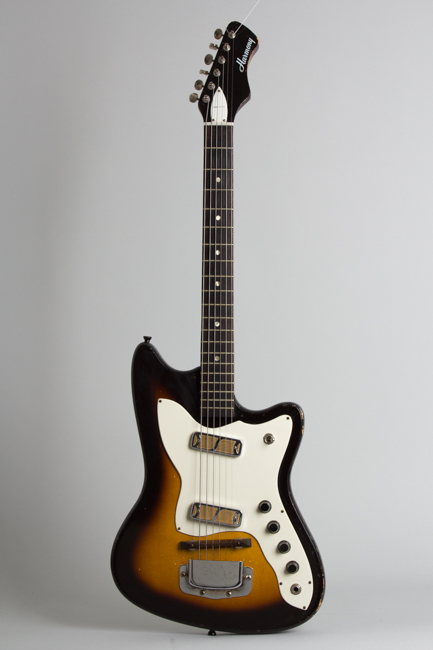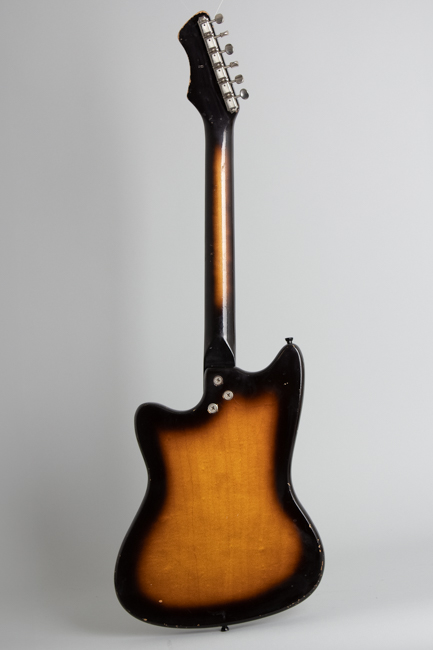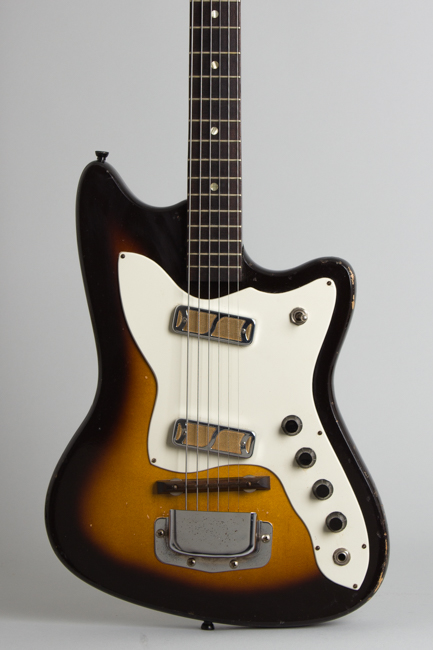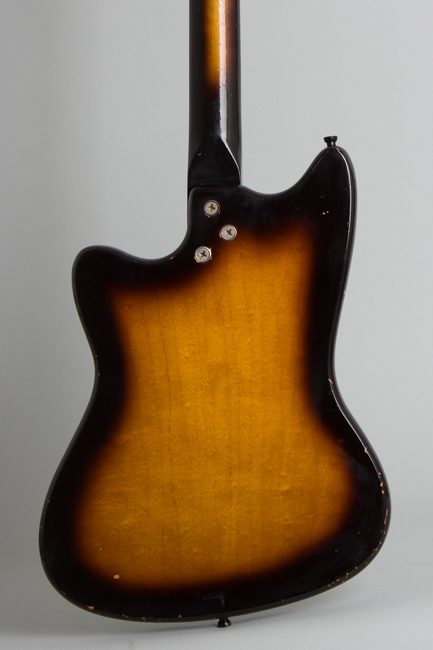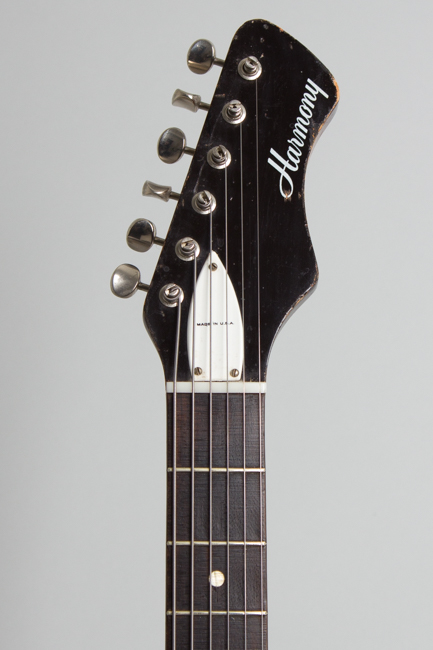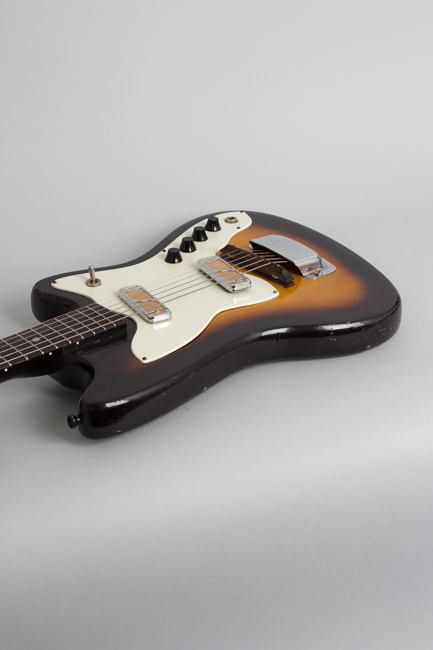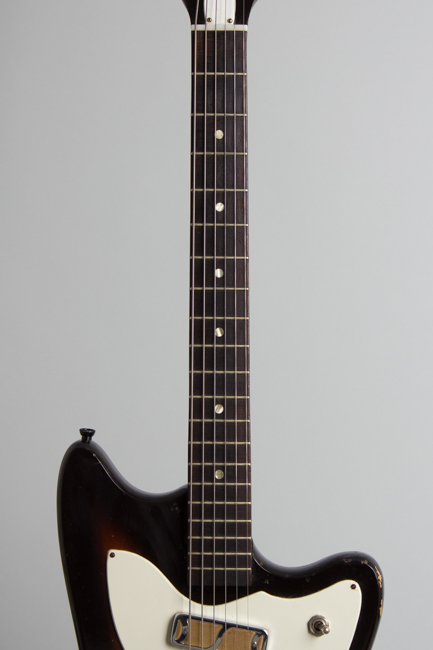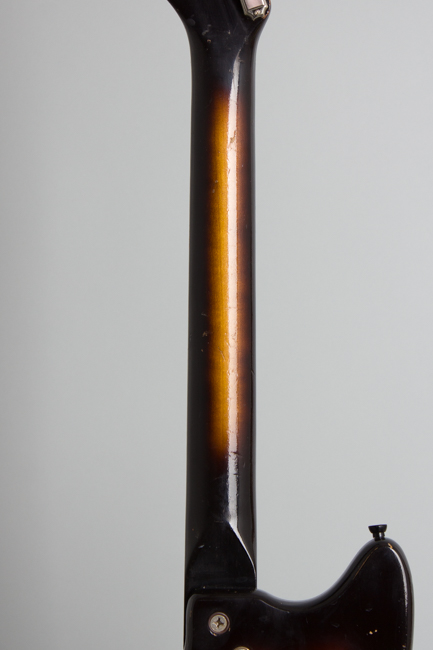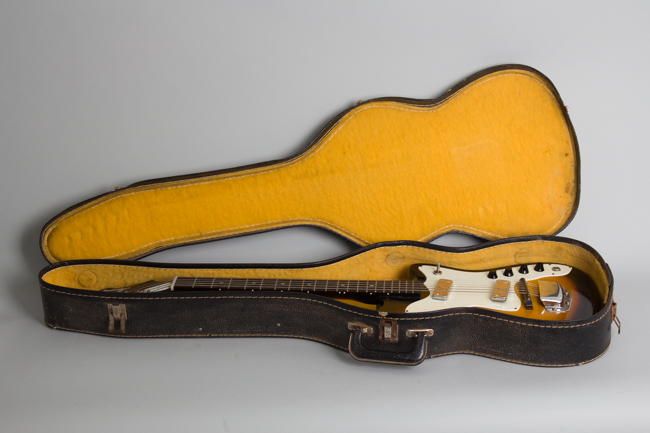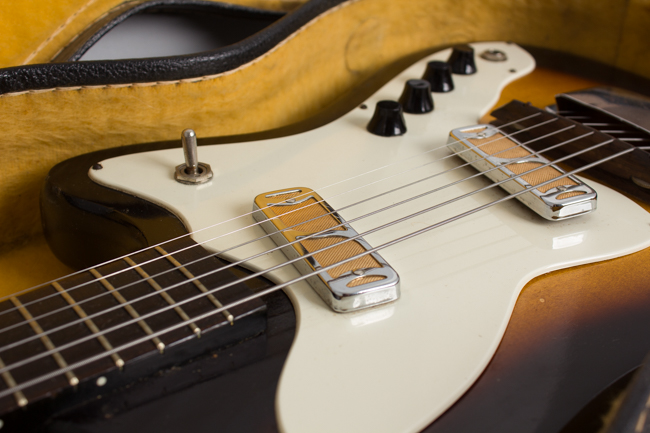Harmony H-15 Silhouette Solid Body Electric Guitar (1965)
Harmony H-15 Silhouette Model Solid Body Electric Guitar (1965), Chicago.
If you were 15 years old in 1965 and enamored of, say, the Rolling Stones you could have done a lot worse than this guitar. The Silhouette series (later renamed Bobkats) were Harmony's least expensive solidbodies, with the H-15 in the middle of the line offering two pickups with no vibrato. This is a pretty basic guitar but has some good points: the pickups are the excellent and now revered Gold Foil DeArmonds, and the neck is equipped with an honest-to-god adjustable truss rod that actually works (unlike many from this era!).
The 2-pickup, 4-knob white plastic pickguard unit came pre-wired from DeArmond; this guitar's assembly was date-stamped on November 1 1965. Harmony mounted it on a vaguely Fender like offset solid body, with an adjustable wooden bridge and one-piece stamped tailpiece; vibrato models were also offered. The bolt-on neck also echoed Fender ("The most imitated guitar in the world" as their ads noted) albeit with a somewhat chunkier round-backed feel. Listing at $87.50 in 1966 this was actually a solid value in an amateur level electric to "Give you what you want for today's music and playing style" as Harmony's catalog blithely put it. Today these humble Harmony solid bodies continue to offer a cool vibe and great sound, and still at a relative bargain price for a 1960s American-made guitar.
Overall length is 36 1/2 in. (92.7 cm.), 12 5/8 in. (32.1 cm.) wide at lower bout, and 1 3/8 in. (3.5 cm.) in depth, measured at side of rim. Scale length is 24 in. (610 mm.). Width of nut is 1 11/16 in. (43 mm.).
This little garage band standby has seen some use along the way but remains original except for an upgrade to repro Kluson Deluxe tuners, replacing the original single openback Waverly strip. The all-original finish has dings, dents and chips overall, especially to the body and headstock edges. All hardware (excepting as noted the tuners) is original with some light wear; the pickguard has a tiny shrinkage crack at the forward lower tip but is otherwise intact. The neck is straight, the truss rod works well and the frets show only minor wear; this is a good playing and great sounding example of this humble Chicago classic. Overall Very Good + Condition.
If you were 15 years old in 1965 and enamored of, say, the Rolling Stones you could have done a lot worse than this guitar. The Silhouette series (later renamed Bobkats) were Harmony's least expensive solidbodies, with the H-15 in the middle of the line offering two pickups with no vibrato. This is a pretty basic guitar but has some good points: the pickups are the excellent and now revered Gold Foil DeArmonds, and the neck is equipped with an honest-to-god adjustable truss rod that actually works (unlike many from this era!).
The 2-pickup, 4-knob white plastic pickguard unit came pre-wired from DeArmond; this guitar's assembly was date-stamped on November 1 1965. Harmony mounted it on a vaguely Fender like offset solid body, with an adjustable wooden bridge and one-piece stamped tailpiece; vibrato models were also offered. The bolt-on neck also echoed Fender ("The most imitated guitar in the world" as their ads noted) albeit with a somewhat chunkier round-backed feel. Listing at $87.50 in 1966 this was actually a solid value in an amateur level electric to "Give you what you want for today's music and playing style" as Harmony's catalog blithely put it. Today these humble Harmony solid bodies continue to offer a cool vibe and great sound, and still at a relative bargain price for a 1960s American-made guitar.
Overall length is 36 1/2 in. (92.7 cm.), 12 5/8 in. (32.1 cm.) wide at lower bout, and 1 3/8 in. (3.5 cm.) in depth, measured at side of rim. Scale length is 24 in. (610 mm.). Width of nut is 1 11/16 in. (43 mm.).
This little garage band standby has seen some use along the way but remains original except for an upgrade to repro Kluson Deluxe tuners, replacing the original single openback Waverly strip. The all-original finish has dings, dents and chips overall, especially to the body and headstock edges. All hardware (excepting as noted the tuners) is original with some light wear; the pickguard has a tiny shrinkage crack at the forward lower tip but is otherwise intact. The neck is straight, the truss rod works well and the frets show only minor wear; this is a good playing and great sounding example of this humble Chicago classic. Overall Very Good + Condition.
